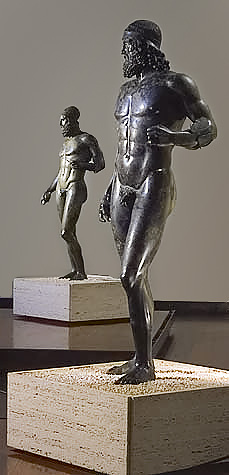The Riace bronze
- aka the Riace Warriors
- aka Bronzi di Riace [Italian /ˈbrondzi di riˈaːtʃe/]
Two full-size Greek bronzes of naked bearded warriors found in the sea near Riace in 1972.
 |
The Riace Warriors
- Phidias in c.460–450 BC
- bronze (Statue A 198 cm, Statue B 197 cm)
- Museo Nazionale della Magna Grecia
(Reggio Calabria, Italy)
|
The Winged Victory of Samothrace
- aka the Nike of Samothrace
A marble Hellenistic sculpture of Nike (the Greek goddess of victory)
| The Winged Nike - Parian marble (244 cm) c.200–190 BC - Louvre (Paris) |
Boy with Thorn
- aka Fedele (Fedelino) or Spinario
A Greco-Roman Hellenistic bronze sculpture of a boy withdrawing a thorn from the sole of his foot.
| Boy with Thorn - bronze (73 cm) - Musei Capitolini (Rome) |
Farnese Cup
- aka Tazza Farnese
A carving bowl or cup in four-layered sardonyx agate. Similar in form to a Greek phiale or Roman patera, with no foot. It features relief carvings on both its exterior and interior surfaces.
 |
| Farnese Cup - made in Hellenistic Egypt - cameo hardstone (20 cm dia.) 2°C BC - National Archaeological Museum (Naples) |
The Pergamon Altar
A monumental construction built on one of the terraces of the acropolis of the ancient Greek city of Pergamon in Asia Minor.
 |
| The Pergamon Altar - first half of the 2°C BC - (35.64 m wide, 33.4 m deep; the front stairway 20 m wide) - Berlin Pergamon Museum |
West frieze (left side, at the north risalit)
 |
| Left to right: Nereus, Doris, a Giant, and Oceanus |
The Parthenon Marbles
- aka Elgin Marbles
A collection of Classical Greek marble sculptures, which were originally part of the temple of the Parthenon and other buildings on the Acropolis of Athens.
 |
| Parthenon Marbles - Phidiasa in c.447–438 BC - marble (75 m) - British Museum (London) |
Laocoön and His Sons
- aka the Laocoon Group
Copy after an Hellenistic original from c.200 BC.
 |
Laocoön and His Sons
- marble (2.4 m) early 1°C BCE
- Museo Pio-Clementino (Vatican City)
|
The Equestrian Statue of Marcus Aurelius
Roman emperor from 161 to 180 and a Stoic philosopher.
 |
Equestrian Statue of Marcus Aurelius
- bronze (4.24 m)
- Capitoline Museum (Rome)
|
'He is riding without the use of stirrups, which had not yet been introduced to the West.'
Portrait bust of Vespasian
/vɛˈspeɪʒ(i)ən/
Roman emperor from 69 to 79.
Marble bust of Hadrian
/ˈheɪdriən/
Roman emperor from 117 to 138
 |
Equestrian Statue of Marcus Aurelius (replica)
- bronze (4.24 m) 1981
- Piazza del Campidoglio (Rome)
|
Portrait bust of Vespasian
/vɛˈspeɪʒ(i)ən/
Roman emperor from 69 to 79.
 |
Vespasian
- marble
- Palazzo Massimo alle Terme (Rome)
|
Marble bust of Hadrian
/ˈheɪdriən/
Roman emperor from 117 to 138
 |
| Hadrian (wearing military dress) - marble - National Archaeological Museum (Venice) |
 |
The location of Hadrian's Wall in what is now northern England,and the later Antonine Wall in modern-day Scotland |
Source: Wikipedia
Reference: Learning to Look at Sculpture (Mary Acton)
Reference: Learning to Look at Sculpture (Mary Acton)

No comments:
Post a Comment